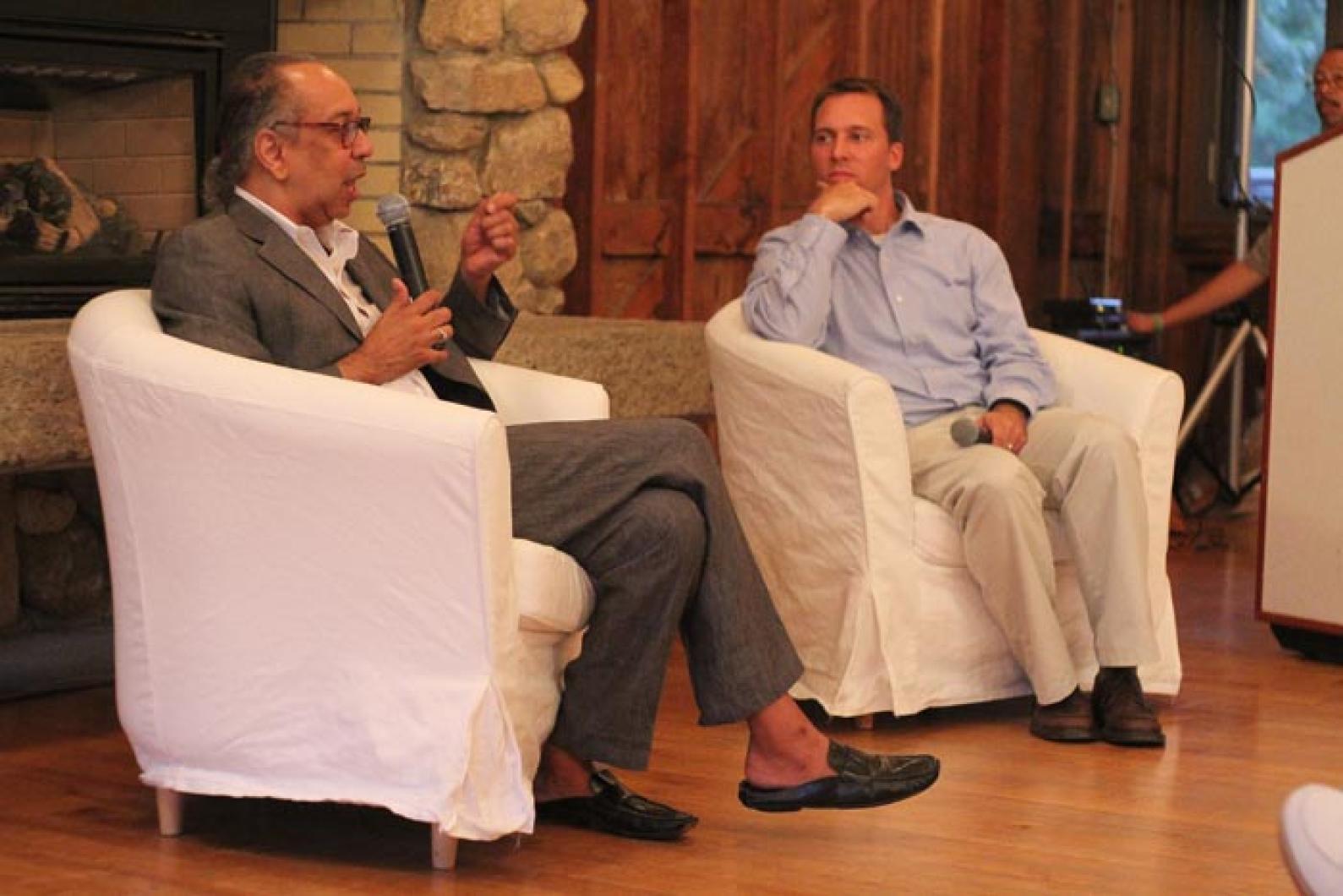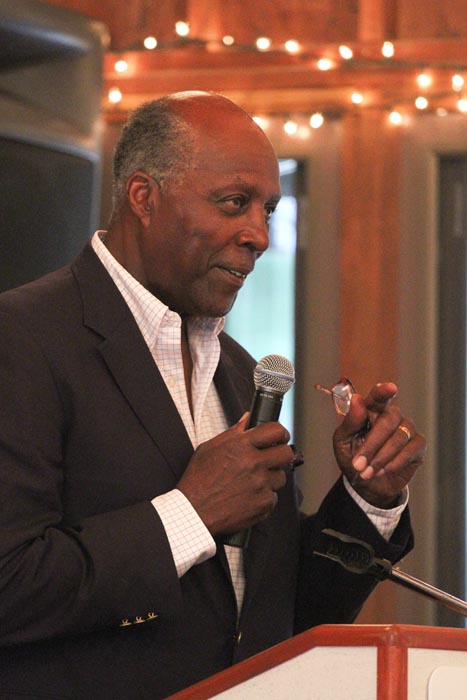As playwright, theatre and film director George C. Wolfe tells it, the event which first motivated him toward the arts was the same one that led him to his latest ambitious project, presenting the history of the American civil rights movement.
That moment, which set him on his course toward the arts, the plaudits for his stage and screen work, the Tony awards, and now the new job as chief creative officer for the nascent National Center for Civil and Human Rights, came in 1964 when he was a boy of 10, in the small town of Franklin, Ky.
His black school had been invited to perform at a nearby white school. Their teacher drummed into them the lines of a song they were to sing. Almost 50 years later, Mr. Wolfe recited them again on Sunday, to his audience at the Sailing Camp in Oak Bluffs.
“These truths we are declaring, that all men are the same.
“That liberty’s a torch burning with a steady flame.”
It was not just the sentiment of the lines themselves that made an impression on him; it was the teacher’s instruction on how they were to be delivered.
The children were told that if they delivered the second line with “passion and force and belief it would shatter every ounce of racism that existed in that room,” he said.
And singing those lines in front of the white kids was, he said, “the most astonishing and important thing that ever happened to me in terms of becoming an artist.
“At the age of 10 I was told if I committed fully to language, if I committed fully to the passion, if I believed what I was saying, I would in fact change the world.”
Ever since, his theatrical work was always committed to identifying and defying boundaries. His work for the National Center for Civil and Human Rights, planned to open in Atlanta in 2014, was motivated by the same thing, he said.
Sunday’s event was billed not as a fundraiser for the center, but as a “friend-raiser,” intended to share ideas and get feedback on the plans. So far the center has a location — on land donated by the Coca Cola Company in downtown Atlanta, and some $76 million in the kitty.
It also has an ambitious goal: not simply to document the struggles of the civil rights movement in America, but to speak to contemporary human rights issues in America and elsewhere.
The center’s CEO, Doug Shipman, told the crowd that one of the two main displays at the center would look back to the history of the civil rights movement, and one would look forward at its legacy.
There would be performance spaces and a broadcast center. Things would change on a weekly and monthly basis in response to current events, so visitors might see how the principles which drove the civil rights movement half a century ago still apply today.
As evidence of their continuing relevance, Mr. Shipman cited a banner waved by a participant in the revolution in Egypt, which read “I am a man.” Saudi Arabian women seeking the right to drive call themselves “freedom riders,” he said.
But here in America the majority of people had no memory of the spirit of revolution of the 1960s and often no sense of how change had been effected here and might be again.
It was in pursuit of that mission of creating something more dynamic than a standard museum that Mr. Shipman turned to Mr. Wolfe, Broadway director whose work includes Angels in America, Bring in da Noise/Bring in da Funk and most recently, The Normal Heart.
And Mr. Wolfe in turn took the job because he wanted visitors to the center to experience something similar to his epiphanous moment, to come to the realization that one person can change things, maybe to catch the eye of someone else having the same experience, and “start a movement.”
Or perhaps restart a movement. For among the crowd of black movers and shakers gathered at the Sailing Camp Park to talk about the plans for the center, there were many people of an age to have been involved in the civil rights cause of the 1950s and 1960s, but precious few born after 1970.
If those younger people were to be re-engaged, Mr. Wolfe said, they needed to experience something more than displays of the “pain of history.” Something more than a passive, intellectual experience.
The story of the civil rights movement was inherently dramatic, he said, and he saw his work at the center as being the same as his stage and screen work, which was to locate “the intimacy and urgency” of that story.
That would take multiple forms of presentation. Standard museum forms, for sure, but also documentary, theatre and modern interactive media.
“With documentaries you can create the intimacy and the power of the moment. Theatre gives this incredible visceral potency to it and a traditional museum has the intellectual equation,” he said.
He cited several examples. How, for one, could a 14-year-old of today be made to know the mental discipline that allowed activists back then “to get up, press your shirt, put on a tie, put on your gloves to match your outfit, sit at a counter and have someone throw mustard on you?”
Answer: through a virtual game “where your hands are placed on a counter, and if you lift [them] and respond to stimuli that are flying at you, you lose points.”
For another, a visitor might enter the reconstructed office of Birmingham, Alabama’s infamous and ironically titled commissioner of public safety, Bull Connor, wherein there would be a small television showing scenes of the violence perpetrated against black protesters.
Then suddenly, the images would become life-size, on the walls of the room, happening all around the visitor.
“Suddenly you’re in it,” he said.
Such a presentation would have the potency of theatre by “juxtaposing the visceral and cerebral response.”
As for the dreadful violence of an incident like the torture and killing of Emmett Till, it would be contextualized by contrast.
People would be exposed first to the vibrant spiritual, social and intellectual life of black communities, “like you are walking inside of this living scrapbook.”
And then they would see images of the violence perpetrated against those communities.
Thus the visitors would come to feel as black communities did, the sense of protection within the group and threat outside. “Celebration versus terrorism,” as he put it.
The point in each case was not just to get people to know what happened, but to feel what happened. And in particular to feel the power of community and the courage of people “who said no in the presence of a wrong.”
And ultimately, not to teach them just about history, but about their capacity to effect change.
“Too many people feel powerless,” he said.
What he wanted people to draw from the civil rights movement of the past, and carry forward into the human rights challenges of today was the realization that “I have power in my voice, because people like me had power in their voice.
“I can change, I can risk something, I can stand up. I think it’s the most important thing,” Mr. Wolfe said.








Comments
Comment policy »